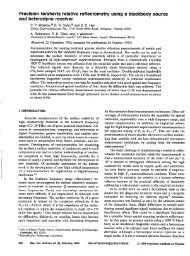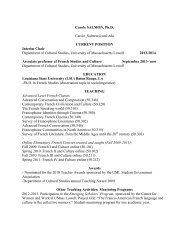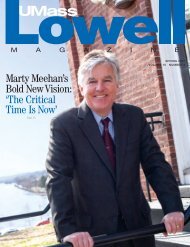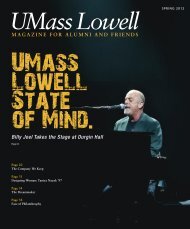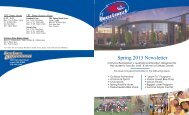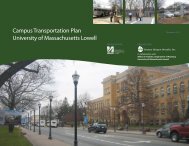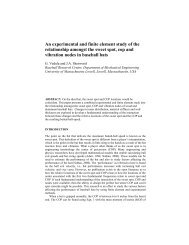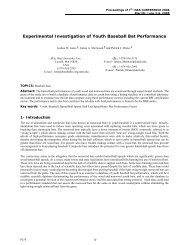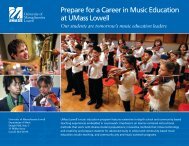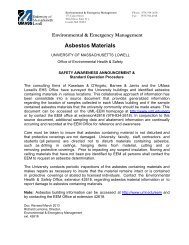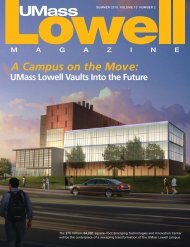Summer 2011 - University of Massachusetts Lowell
Summer 2011 - University of Massachusetts Lowell
Summer 2011 - University of Massachusetts Lowell
Create successful ePaper yourself
Turn your PDF publications into a flip-book with our unique Google optimized e-Paper software.
C A M P U S N E W S<br />
SENSOR DETECTS<br />
EXPLOSIVES, IMPROVES<br />
HOMELAND SECURITY<br />
On Christmas Day 2009, a 23-year-old Nigerian passenger aboard a<br />
Northwest Airlines flight from Amsterdam tried to ignite a homemade<br />
explosive device hidden in his underwear as the plane was preparing to<br />
land in Detroit. Fortunately, the plot was foiled before anyone<br />
was seriously hurt or killed. The incident, however, highlights the<br />
need for the United States to be ever more vigilant in the face <strong>of</strong> global<br />
terrorism.<br />
A group <strong>of</strong> UMass <strong>Lowell</strong> researchers has developed a highly sensitive<br />
optical sensor that can rapidly detect even trace amounts <strong>of</strong> explosives<br />
in the air. Such a sensor could be used to screen passengers, luggage and<br />
cargo at airports across the country to help safeguard the nation’s<br />
aviation infrastructure.<br />
“Explosives like TNT and PETN are very hard to detect because <strong>of</strong><br />
their extremely low vapor pressure, typically only a few molecules per<br />
billion air molecules at room temperature,” says Abhishek Kumar, a<br />
physics graduate student involved in the project at the Center for Advanced<br />
Materials (CAM). “Our optical sensor can detect less than a<br />
picogram, or a trillionth <strong>of</strong> a gram, <strong>of</strong> explosive in vapor phase under<br />
room temperature in a matter <strong>of</strong> seconds.”<br />
Physics pr<strong>of</strong>essor and CAM Director Jayant Kumar led the sensor’s<br />
development. The group also includes Mukesh Pandey, a postdoctoral<br />
fellow at UMass <strong>Lowell</strong> who has been with Harvard Medical School<br />
since 2009. Their work has been funded by four-year grants from the<br />
National Science Foundation and the Army Research Lab totaling<br />
about $500,000.<br />
To create the sensor, the team used organic fluorescent materials —<br />
such as certain kinds <strong>of</strong> dyes and semiconducting polymers — that<br />
respond to the trace elements <strong>of</strong> explosives in the air. A thin film <strong>of</strong> the<br />
organic solution is smeared on a flat surface, like a glass slide, and<br />
exposed to the air being tested. By shining ultraviolet light on the<br />
film’s surface and measuring the amount <strong>of</strong> fluorescent light emitted,<br />
it’s possible to quickly determine whether molecules <strong>of</strong> explosives have<br />
adhered to the surface.<br />
SENSOR DETECTS<br />
SALMONELLA, E.COLI<br />
A mechanical engineering pr<strong>of</strong>essor<br />
is developing a new tool that will<br />
help ensure that what you eat or<br />
drink doesn’t make you sick.<br />
“My students and I are designing a<br />
simple sensor for rapidly detecting<br />
major disease-causing microorganisms<br />
in food, especially in raw chicken,<br />
eggs, ground beef and dairy products,”<br />
says Hongwei Sun, an expert<br />
in micro electro-mechanical systems.<br />
The National Science Foundation<br />
recognized the importance <strong>of</strong> his<br />
work and awarded him with a threeyear,<br />
$100,000 grant.<br />
The U.S. Centers for Disease<br />
Control and Prevention estimates<br />
that each year, roughly one in six<br />
Americans — or about 48 million<br />
people — gets sick from bacteria,<br />
viruses or microbes. Of these, about<br />
128,000 are hospitalized and about<br />
3,000 die from complications.<br />
These foodborne pathogens include<br />
norovirus, salmonella, clostridium,<br />
campylobacter, staphylococcus<br />
aureus, toxoplasma, listeria and<br />
E. coli. The health costs associated<br />
with the resulting illnesses run in<br />
the billions <strong>of</strong> dollars.<br />
“We will combine magnetic immunoassays<br />
with micro Coulter<br />
counting techniques to achieve<br />
simultaneous detection <strong>of</strong> multiple<br />
pathogenic bacteria in foods with<br />
high specificity and sensitivity,” says<br />
Sun. “Our method, once optimized,<br />
can potentially be applied to detecting<br />
a wide range <strong>of</strong> other targets,<br />
such as viruses, toxins and diseaserelated<br />
biomarkers.”<br />
In addition to improved food and<br />
water safety and enhanced public<br />
health and homeland security,<br />
Sun says the project <strong>of</strong>fers a multidisciplinary<br />
training ground for<br />
undergraduate and graduate students<br />
involved in the research.<br />
STUDENTS’ GREEN PROJECT WINS<br />
$75,000 EPA AWARD<br />
Students who have developed a way to use a byproduct <strong>of</strong> processing<br />
cashew nut shells to make firepro<strong>of</strong> fabric have been recognized<br />
for their work by the Environmental Protection Agency (EPA).<br />
Polymer science graduate student Sethumadhavan Ravichandran<br />
and chemical engineering graduate student Ryan Bouldin<br />
teamed up with physics Pr<strong>of</strong>. Jayant Kumar and plastics engineering<br />
Asst. Pr<strong>of</strong>. Ramaswamy Nagarajan in designing a safer,<br />
“greener” method<br />
for producing flameresistant<br />
materials.<br />
For their effort,<br />
the team was recently<br />
chosen by the EPA to<br />
receive a $75,000 People,<br />
Prosperity and the Planet<br />
(P3) award during the<br />
National Sustainable<br />
Design Expo held at<br />
the National Mall in<br />
Washington, D.C. UMass<br />
<strong>Lowell</strong> was one <strong>of</strong> only<br />
five schools to win the<br />
coveted P3 award.<br />
Pr<strong>of</strong>. Jayant Kumar, Ryan Bouldin,<br />
Sethumadhavan Ravichandran and Asst.<br />
Pr<strong>of</strong>. Ramaswamy Nagarajan.<br />
S U M M E R 2 0 1 1 UMASS LOWELL MAGAZINE 1 5



